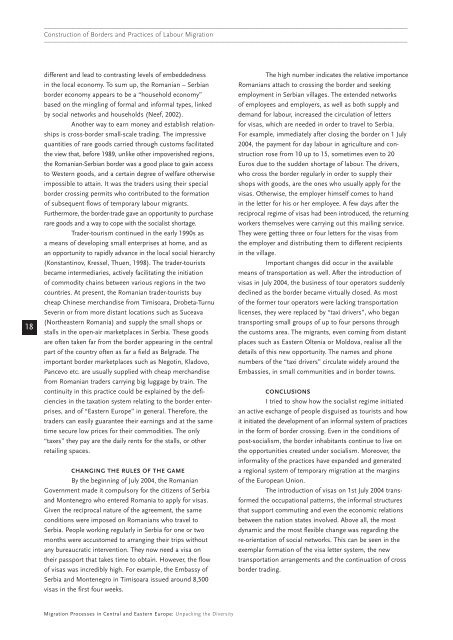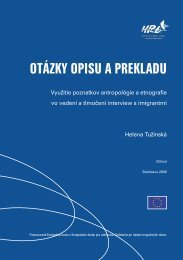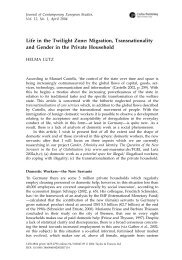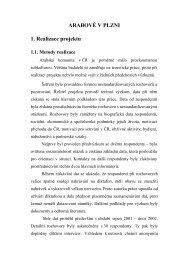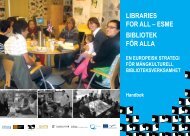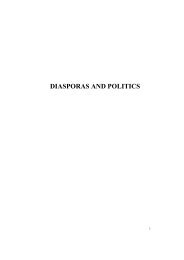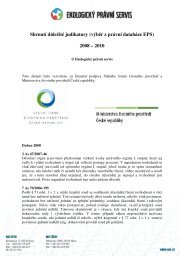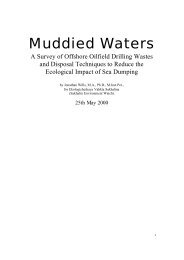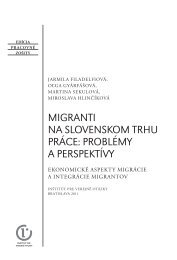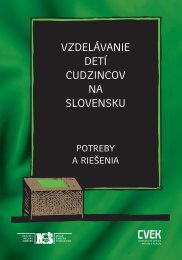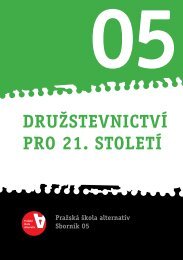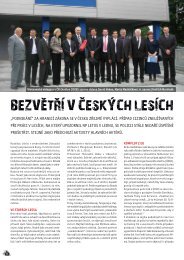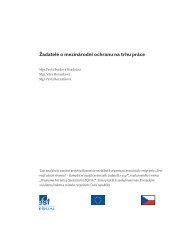Migration Processes in Central and Eastern Europe - Multiple Choices
Migration Processes in Central and Eastern Europe - Multiple Choices
Migration Processes in Central and Eastern Europe - Multiple Choices
Create successful ePaper yourself
Turn your PDF publications into a flip-book with our unique Google optimized e-Paper software.
———————————————————————————————————————————————————————————————<br />
Construction of Borders <strong>and</strong> Practices of Labour <strong>Migration</strong><br />
———————————————————————————————————————————————————————————————<br />
18<br />
different <strong>and</strong> lead to contrast<strong>in</strong>g levels of embeddedness<br />
<strong>in</strong> the local economy. To sum up, the Romanian – Serbian<br />
border economy appears to be a “household economy”<br />
based on the m<strong>in</strong>gl<strong>in</strong>g of formal <strong>and</strong> <strong>in</strong>formal types, l<strong>in</strong>ked<br />
by social networks <strong>and</strong> households (Neef, 2002).<br />
Another way to earn money <strong>and</strong> establish relationships<br />
is cross-border small-scale trad<strong>in</strong>g. The impressive<br />
quantities of rare goods carried through customs facilitated<br />
the view that, before 1989, unlike other impoverished regions,<br />
the Romanian-Serbian border was a good place to ga<strong>in</strong> access<br />
to Western goods, <strong>and</strong> a certa<strong>in</strong> degree of welfare otherwise<br />
impossible to atta<strong>in</strong>. It was the traders us<strong>in</strong>g their special<br />
border cross<strong>in</strong>g permits who contributed to the formation<br />
of subsequent flows of temporary labour migrants.<br />
Furthermore, the border-trade gave an opportunity to purchase<br />
rare goods <strong>and</strong> a way to cope with the socialist shortage.<br />
Trader-tourism cont<strong>in</strong>ued <strong>in</strong> the early 1990s as<br />
a means of develop<strong>in</strong>g small enterprises at home, <strong>and</strong> as<br />
an opportunity to rapidly advance <strong>in</strong> the local social hierarchy<br />
(Konstant<strong>in</strong>ov, Kressel, Thuen, 1998). The trader-tourists<br />
became <strong>in</strong>termediaries, actively facilitat<strong>in</strong>g the <strong>in</strong>itiation<br />
of commodity cha<strong>in</strong>s between various regions <strong>in</strong> the two<br />
countries. At present, the Romanian trader-tourists buy<br />
cheap Ch<strong>in</strong>ese merch<strong>and</strong>ise from Timis‚oara, Drobeta-Turnu<br />
Sever<strong>in</strong> or from more distant locations such as Suceava<br />
(Northeastern Romania) <strong>and</strong> supply the small shops or<br />
stalls <strong>in</strong> the open-air marketplaces <strong>in</strong> Serbia. These goods<br />
are often taken far from the border appear<strong>in</strong>g <strong>in</strong> the central<br />
part of the country often as far a field as Belgrade. The<br />
important border marketplaces such as Negot<strong>in</strong>, Kladovo,<br />
Pancevo etc. are usually supplied with cheap merch<strong>and</strong>ise<br />
from Romanian traders carry<strong>in</strong>g big luggage by tra<strong>in</strong>. The<br />
cont<strong>in</strong>uity <strong>in</strong> this practice could be expla<strong>in</strong>ed by the deficiencies<br />
<strong>in</strong> the taxation system relat<strong>in</strong>g to the border enterprises,<br />
<strong>and</strong> of “<strong>Eastern</strong> <strong>Europe</strong>” <strong>in</strong> general. Therefore, the<br />
traders can easily guarantee their earn<strong>in</strong>gs <strong>and</strong> at the same<br />
time secure low prices for their commodities. The only<br />
“taxes” they pay are the daily rents for the stalls, or other<br />
retail<strong>in</strong>g spaces.<br />
CHANGING THE RULES OF THE GAME<br />
By the beg<strong>in</strong>n<strong>in</strong>g of July 2004, the Romanian<br />
Government made it compulsory for the citizens of Serbia<br />
<strong>and</strong> Montenegro who entered Romania to apply for visas.<br />
Given the reciprocal nature of the agreement, the same<br />
conditions were imposed on Romanians who travel to<br />
Serbia. People work<strong>in</strong>g regularly <strong>in</strong> Serbia for one or two<br />
months were accustomed to arrang<strong>in</strong>g their trips without<br />
any bureaucratic <strong>in</strong>tervention. They now need a visa on<br />
their passport that takes time to obta<strong>in</strong>. However, the flow<br />
of visas was <strong>in</strong>credibly high. For example, the Embassy of<br />
Serbia <strong>and</strong> Montenegro <strong>in</strong> Timis‚oara issued around 8,500<br />
visas <strong>in</strong> the first four weeks.<br />
The high number <strong>in</strong>dicates the relative importance<br />
Romanians attach to cross<strong>in</strong>g the border <strong>and</strong> seek<strong>in</strong>g<br />
employment <strong>in</strong> Serbian villages. The extended networks<br />
of employees <strong>and</strong> employers, as well as both supply <strong>and</strong><br />
dem<strong>and</strong> for labour, <strong>in</strong>creased the circulation of letters<br />
for visas, which are needed <strong>in</strong> order to travel to Serbia.<br />
For example, immediately after clos<strong>in</strong>g the border on 1 July<br />
2004, the payment for day labour <strong>in</strong> agriculture <strong>and</strong> construction<br />
rose from 10 up to 15, sometimes even to 20<br />
Euros due to the sudden shortage of labour. The drivers,<br />
who cross the border regularly <strong>in</strong> order to supply their<br />
shops with goods, are the ones who usually apply for the<br />
visas. Otherwise, the employer himself comes to h<strong>and</strong><br />
<strong>in</strong> the letter for his or her employee. A few days after the<br />
reciprocal regime of visas had been <strong>in</strong>troduced, the return<strong>in</strong>g<br />
workers themselves were carry<strong>in</strong>g out this mail<strong>in</strong>g service.<br />
They were gett<strong>in</strong>g three or four letters for the visas from<br />
the employer <strong>and</strong> distribut<strong>in</strong>g them to different recipients<br />
<strong>in</strong> the village.<br />
Important changes did occur <strong>in</strong> the available<br />
means of transportation as well. After the <strong>in</strong>troduction of<br />
visas <strong>in</strong> July 2004, the bus<strong>in</strong>ess of tour operators suddenly<br />
decl<strong>in</strong>ed as the border became virtually closed. As most<br />
of the former tour operators were lack<strong>in</strong>g transportation<br />
licenses, they were replaced by “taxi drivers”, who began<br />
transport<strong>in</strong>g small groups of up to four persons through<br />
the customs area. The migrants, even com<strong>in</strong>g from distant<br />
places such as <strong>Eastern</strong> Oltenia or Moldova, realise all the<br />
details of this new opportunity. The names <strong>and</strong> phone<br />
numbers of the “taxi drivers” circulate widely around the<br />
Embassies, <strong>in</strong> small communities <strong>and</strong> <strong>in</strong> border towns.<br />
CONCLUSIONS<br />
I tried to show how the socialist regime <strong>in</strong>itiated<br />
an active exchange of people disguised as tourists <strong>and</strong> how<br />
it <strong>in</strong>itiated the development of an <strong>in</strong>formal system of practices<br />
<strong>in</strong> the form of border cross<strong>in</strong>g. Even <strong>in</strong> the conditions of<br />
post-socialism, the border <strong>in</strong>habitants cont<strong>in</strong>ue to live on<br />
the opportunities created under socialism. Moreover, the<br />
<strong>in</strong>formality of the practices have exp<strong>and</strong>ed <strong>and</strong> generated<br />
a regional system of temporary migration at the marg<strong>in</strong>s<br />
of the <strong>Europe</strong>an Union.<br />
The <strong>in</strong>troduction of visas on 1st July 2004 transformed<br />
the occupational patterns, the <strong>in</strong>formal structures<br />
that support commut<strong>in</strong>g <strong>and</strong> even the economic relations<br />
between the nation states <strong>in</strong>volved. Above all, the most<br />
dynamic <strong>and</strong> the most flexible change was regard<strong>in</strong>g the<br />
re-orientation of social networks. This can be seen <strong>in</strong> the<br />
exemplar formation of the visa letter system, the new<br />
transportation arrangements <strong>and</strong> the cont<strong>in</strong>uation of cross<br />
border trad<strong>in</strong>g.<br />
<strong>Migration</strong> <strong>Processes</strong> <strong>in</strong> <strong>Central</strong> <strong>and</strong> <strong>Eastern</strong> <strong>Europe</strong>: Unpack<strong>in</strong>g the Diversity


